Developing a Model to Study Walking and Public Transport to Attractive Green Spaces for Equitable Access to Health and Socializing Opportunities as a Response to Climate Change: Testing the Model in Pu’er City, China
Abstract
1. Introduction
2. Application of PSG to Interaction Intensity Measurements
2.1. Research Area and Data
2.1.1. Overview of the Research Area
2.1.2. Big Data of Mobile Geographic Location
2.1.3. Other Basic Data
2.2. Method
2.2.1. Construction of a Preferred Green Space Selection Model
2.2.2. Calculation of the Attractiveness of Recreational Green Spaces
2.2.3. Calculation of Travel Costs
2.2.4. Calculation of the Intensity of the Interaction
3. Results and Analysis
3.1. Spatial Layout Analysis
3.2. Analysis of Travel Costs
3.3. Recreational Green Space Utilization Analysis
4. Discussion
4.1. Advantages of PSG
4.2. Limitations of PSG
5. Conclusions
Author Contributions
Funding
Data Availability Statement
Acknowledgments
Conflicts of Interest
References
- Team, U.-H.C. World Cities Report 2022. 2022. Available online: https://unhabitat.org/wcr/ (accessed on 28 October 2024).
- Khaza, M.K.B.; Rahman, M.M.; Harun, F.; Roy, T.K. Accessibility and service quality of public parks in Khulna city. J. Urban Plan. Dev. 2020, 146, 04020024. [Google Scholar] [CrossRef]
- Guo, R.; Diehl, J.A.; Zhang, R.; Wang, H. Spatial equity of urban parks from the perspective of recreational opportunities and recreational environment quality: A case study in Singapore. Landsc. Urban Plan. 2024, 247, 105065. [Google Scholar] [CrossRef]
- Gao, S.; Zhai, W.; Fu, X. Green space justice amid COVID-19: Unequal access to public green space across American neighborhoods. Front. Public Health 2023, 11, 1055720. [Google Scholar] [CrossRef]
- Li, H.; Ta, N.; Yu, B.; Wu, J. Are the accessibility and facility environment of parks associated with mental health? A comparative analysis based on residential areas and workplaces. Landsc. Urban Plan. 2023, 237, 104807. [Google Scholar] [CrossRef]
- Colbert, J.; Chuang, I.T.; Sila-Nowicka, K. Measuring spatial inequality of urban park accessibility and utilisation: A case study of public housing developments in Auckland, New Zealand. Landsc. Urban Plan. 2024, 247, 105070. [Google Scholar] [CrossRef]
- Rodrigues Ferreira Barbosa, V.; Maria Damasceno, R.; Andreotti Dias, M.; Castelhano, F.J.; Roig, H.L.; Requia, W.J. Ecosystem services provided by green areas and their implications for human health in Brazil. Ecol. Indic. 2024, 161, 111975. [Google Scholar] [CrossRef]
- Oh, K.; Jeong, S. Assessing the spatial distribution of urban parks using GIS. Landsc. Urban Plan. 2007, 82, 25–32. [Google Scholar] [CrossRef]
- Kong, F.; Yin, H.; Nakagoshi, N. Using GIS and landscape metrics in the hedonic price modeling of the amenity value of urban green space: A case study in Jinan City, China. Landsc. Urban Plan. 2007, 79, 240–252. [Google Scholar] [CrossRef]
- Guo, S.; Song, C.; Pei, T.; Liu, Y.; Ma, T.; Du, Y.; Chen, J.; Fan, Z.; Tang, X.; Peng, Y.; et al. Accessibility to urban parks for elderly residents: Perspectives from mobile phone data. Landsc. Urban Plan. 2019, 191, 103642. [Google Scholar] [CrossRef]
- Wang, S.; Wang, M.; Liu, Y. Access to urban parks: Comparing spatial accessibility measures using three GIS-based approaches. Comput. Environ. Urban Syst. 2021, 90, 101713. [Google Scholar] [CrossRef]
- Stoia, N.L.; Nita, M.R.; Popa, A.M.; Iojă, I.C. The green walk—An analysis for evaluating the accessibility of urban green spaces. Urban For. Urban Green. 2022, 75, 127685. [Google Scholar] [CrossRef]
- Mohamed, A.A.; Kronenberg, J.; Laszkiewicz, E. Transport infrastructure modifications and accessibility to public parks in Greater Cairo. Urban For. Urban Green. 2022, 73, 127599. [Google Scholar] [CrossRef]
- Shi, M.; Chen, M.; Jia, W.; Du, C.; Wang, Y. Cooling effect and cooling accessibility of urban parks during hot summers in China’s largest sustainability experiment. Sustain. Cities Soc. 2023, 93, 104519. [Google Scholar] [CrossRef]
- Zong, W.; Qin, L.; Jiao, S.; Chen, H.; Zhang, R. An innovative approach for equitable urban green space allocation through population demand and accessibility modeling. Ecol. Indic. 2024, 160, 111861. [Google Scholar] [CrossRef]
- Wang, Y.; Ouyang, W.; Zhang, J. Matching supply and demand of cooling service provided by urban green and blue space. Urban For. Urban Green. 2024, 96, 128338. [Google Scholar] [CrossRef]
- Xu, S.; Li, J.; Gao, X.; Zhao, H.; Hu, J.; Yuan, S. Framework for analyzing the relationship between supply, demand, and flow of recreational services in urban park green spaces. Ecol. Indic. 2024, 166, 112403. [Google Scholar] [CrossRef]
- Zhang, J.; Tan, P.Y. Assessment of spatial equity of urban park distribution from the perspective of supply-demand interactions. Urban For. Urban Green. 2023, 80, 127827. [Google Scholar] [CrossRef]
- Tong, A.; Xu, L.; Ma, Q.; Shi, Y.; Feng, M.; Lu, Z.; Wu, Y. Evaluation of the level of park space service based on the residential area demand. Urban For. Urban Green. 2024, 93, 128214. [Google Scholar] [CrossRef]
- Fan, P.; Xu, L.; Yue, W.; Chen, J. Accessibility of public urban green space in an urban periphery: The case of Shanghai. Landsc. Urban Plan. 2016, 165, 177–192. [Google Scholar] [CrossRef]
- Guo, R.-Z.; Lin, L.; Xu, J.-F.; Dai, W.-H.; Song, Y.-B.; Dong, M. Spatio-temporal characteristics of cultural ecosystem services and their relations to landscape factors in Hangzhou Xixi National Wetland Park, China. Ecol. Indic. 2023, 154, 110910. [Google Scholar] [CrossRef]
- Shan, X.-Z. Association between the time patterns of urban green space visitations and visitor characteristics in a high-density, subtropical city. Cities 2020, 97, 102562. [Google Scholar] [CrossRef]
- Gong, F.-Y. Modeling walking accessibility to urban parks using Google Maps crowdsourcing database in the high-density urban environments of Hong Kong. Sci. Rep. 2023, 13, 20798. [Google Scholar] [CrossRef] [PubMed]
- Wüstemann, H.; Kalisch, D.; Kolbe, J. Access to urban green space and environmental inequalities in Germany. Landsc. Urban Plan. 2017, 164, 124–131. [Google Scholar] [CrossRef]
- Tan, P.Y.; Samsudin, R. Effects of spatial scale on assessment of spatial equity of urban park provision. Landsc. Urban Plan. 2017, 158, 139–154. [Google Scholar] [CrossRef]
- Edwards, R.C.; Larson, B.M. Accounting for diversity: Exploring the inclusivity of recreation planning in the United Kingdom’s protected areas. Landsc. Urban Plan. 2022, 221, 104361. [Google Scholar] [CrossRef]
- Giuffrida, N.; Pilla, F.; Carroll, P. The social sustainability of cycling: Assessing equity in the accessibility of bike-sharing services. J. Transp. Geogr. 2023, 106, 103490. [Google Scholar] [CrossRef]
- Su, Y.; Zhang, X.; Xuan, Y. Linking neighborhood green spaces to loneliness among elderly residents—A path analysis of social capital. Cities 2024, 149, 104952. [Google Scholar] [CrossRef]
- Delgado-Serrano, M.M.; Melichová, K.; Mac Fadden, I.; Cruz-Piedrahita, C. Perception of green spaces’ role in enhancing mental health and mental well-being in small and medium-sized cities. Land Use Policy 2024, 139, 107087. [Google Scholar] [CrossRef]
- Houlden, V.; De Albuquerque, J.P.; Weich, S.; Jarvis, S. A spatial analysis of proximate greenspace and mental wellbeing in London. Appl. Geogr. 2019, 109, 102036. [Google Scholar] [CrossRef]
- Watkins, S.L.; Mincey, S.K.; Vogt, J.; Sweeney, S.P. Is Planting Equitable? An Examination of the Spatial Distribution of Nonprofit Urban Tree-Planting Programs by Canopy Cover, Income, Race, and Ethnicity. Environ. Behav. 2017, 49, 452–482. [Google Scholar] [CrossRef]
- Chen, Y.; Lin, N.; Wu, Y.; Ding, L.; Pang, J.; Lv, T. Spatial equity in the layout of urban public sports facilities in Hangzhou. PLoS ONE 2021, 16, e0256174. [Google Scholar] [CrossRef] [PubMed]
- Žlender, V.; Thompson, C.W. Accessibility and use of peri-urban green space for inner-city dwellers: A comparative study. Landsc. Urban Plan. 2017, 165, 193–205. [Google Scholar] [CrossRef]
- Zhao, X.; Lu, Y.; Huang, W.; Lin, G. Assessing and interpreting perceived park accessibility, usability and attractiveness through texts and images from social media. Sustain. Cities Soc. 2024, 112, 105619. [Google Scholar] [CrossRef]
- Zhang, J.; Cheng, Y.; Zhao, B. How to accurately identify the underserved areas of peri-urban parks? An integrated accessibility indicator. Ecol. Indic. 2021, 122, 107263. [Google Scholar] [CrossRef]
- Zuo, Y.; Liu, Z.; Fu, X. Measuring accessibility of bus system based on multi-source traffic data. Geo-Spat. Inf. Sci. 2020, 23, 248–257. [Google Scholar] [CrossRef]
- Straczkiewicz, M.; James, P.; Onnela, J.-P. A systematic review of smartphone-based human activity recognition methods for health research. npj Digit. Med. 2021, 4, 148. [Google Scholar] [CrossRef]
- Filazzola, A.; Xie, G.; Barrett, K.; Dunn, A.; Johnson, M.T.J.; MacIvor, J.S. Using smartphone-GPS data to quantify human activity in green spaces. PLoS Comput. Biol. 2022, 18, e1010725. [Google Scholar] [CrossRef]
- Jay, J.; Heykoop, F.; Hwang, L.; Courtepatte, A.; de Jong, J.; Kondo, M. Use of smartphone mobility data to analyze city park visits during the COVID-19 pandemic. Landsc. Urban Plan. 2022, 228, 104554. [Google Scholar] [CrossRef]
- Ye, Y.; Xiang, Y.; Qiu, H.; Li, X. Revealing urban greenspace accessibility inequity using the carrying capacity-based 3SFCA method and location big data. Sustain. Cities Soc. 2024, 108, 105513. [Google Scholar] [CrossRef]
- Zhou, H.; Wang, J.; Wilson, K. Impacts of perceived safety and beauty of park environments on time spent in parks: Examining the potential of street view imagery and phone-based GPS data. Int. J. Appl. Earth Obs. Geoinf. 2022, 115, 103078. [Google Scholar] [CrossRef]
- Zhao, X.; Guo, Y. Planning bikeway network for urban commute based on mobile phone data: A case study of Beijing. Travel Behav. Soc. 2024, 34, 100672. [Google Scholar] [CrossRef]
- Zipf, G.K. The P1 P2D Hypothesis: On the Intercity Movement of Persons. Am. Sociol. Rev. 1946, 11, 677–686. [Google Scholar] [CrossRef]
- Simini, F.; González, M.C.; Maritan, A.; Barabási, A.L. A universal model for mobility and migration patterns. Nature 2012, 484, 96–100. [Google Scholar] [CrossRef] [PubMed]
- Li, F.; Feng, Z.; Li, P.; You, Z. Measuring directional urban spatial interaction in China: A migration perspective. PLoS ONE 2017, 12, e0171107. [Google Scholar] [CrossRef]
- Yan, X.Y.; Zhao, C.; Fan, Y.; Di, Z.; Wang, W.-X. Universal predictability of mobility patterns in cities. J. R. Soc. Interface 2014, 11, 20140834. [Google Scholar] [CrossRef]
- Liu, E.; Yan, X. New parameter-free mobility model: Opportunity priority selection model. Phys. A Stat. Mech. Its Appl. 2019, 526, 121023. [Google Scholar] [CrossRef]
- Jia, X.Y.; Liu, E.J.; Chen, C.Y.; He, Z.; Yan, X.-Y. An interactive city choice model and its application for measuring the intercity interaction. Front. Phys. 2021, 10, 850415. [Google Scholar] [CrossRef]
- Schläpfer, M.; Dong, L.; O’Keeffe, K.; Santi, P.; Szell, M.; Salat, H.; Anklesaria, S.; Vazifeh, M.; Ratti, C.; West, G.B. The universal visitation law of human mobility. Nature 2021, 593, 522–527. [Google Scholar] [CrossRef]
- Yan, X.Y.; Zhou, T. Destination choice game: A spatial interaction theory on human mobility. Sci. Rep. 2019, 9, 9466. [Google Scholar] [CrossRef]
- Kotsubo, M.; Nakaya, T. Kernel-based formulation of intervening opportunities for spatial interaction modelling. Sci. Rep. 2021, 11, 950. [Google Scholar] [CrossRef]
- Ruan, X.-G. How fast is it to city centers? The average travel speed as an indicator of road traffic accessibility potential. J. Zhejiang Univ.-Sci. A 2022, 23, 621–638. [Google Scholar] [CrossRef]
- Guan, C.; Zhou, Y. Exploring environmental equity and visitation disparities in peri-urban parks: A mobile phone data-driven analysis in Tokyo. Landsc. Urban Plan. 2024, 248, 105104. [Google Scholar] [CrossRef]
- Comber, A.; Brunsdon, C.; Green, E. Using a GIS-based network analysis to determine urban greenspace accessibility for different ethnic and religious groups. Landsc. Urban Plan. 2008, 86, 103–114. [Google Scholar] [CrossRef]
- GB 51192-2016; Code for the Design of Public Park. Ministry of Housing and Urban-Rural Development of the People’s Republic of China: Beijing, China, 2016.
- Li, W.; Guan, H.; Qin, W.; Ji, X. Collective and individual spatial equity measure in public transit accessibility based on generalized travel cost. Res. Transp. Econ. 2023, 98, 101263. [Google Scholar] [CrossRef]
- Kirtonia, S.; Sun, Y. Evaluating rail transit’s comparative advantages in travel cost and time over taxi with open data in two U. S. Cities. Transp. Policy 2022, 115, 75–87. [Google Scholar] [CrossRef]
- Ameli, M.; Lebacque, J.-P.; Alisoltani, N.; Leclercq, L. Collective departure time allocation in large-scale urban networks: A flexible modeling framework with trip length and desired arrival time distributions. Transp. Res. Part B Methodol. 2024, 102990. [Google Scholar] [CrossRef]
- Ren, Y.; Ercsey-Ravasz, M.; Wang, P.; González, M.C.; Toroczkai, Z. Predicting commuter flows in spatial networks using a radiation model based on temporal ranges. Nat. Commun. 2014, 5, 5347. [Google Scholar] [CrossRef]
- Kim, E.-K.; Yoon, S.; Jung, S.U.; Kweon, S.J. Optimizing urban park locations with addressing environmental justice in park access and utilization by using dynamic demographic features derived from mobile phone data. Urban For. Urban Green. 2024, 99, 128444. [Google Scholar] [CrossRef]
- Zhang, R.; Peng, S.; Sun, F.; Deng, L.; Che, Y. Assessing the social equity of urban parks: An improved index integrating multiple quality dimensions and service accessibility. Cities 2022, 129, 103839. [Google Scholar] [CrossRef]
- Yu, W.; Ai, T.; Shao, S. The analysis and delimitation of Central Business District using network kernel density estimation. J. Transp. Geogr. 2015, 45, 32–47. [Google Scholar] [CrossRef]
- Li, X.; Deng, Y.; Liu, B.; Yang, J.; Li, M.; Jing, W.; Chen, Z. GDP spatial differentiation in the perspective of urban functional zones. Cities 2024, 151, 105126. [Google Scholar] [CrossRef]
- Powers, S.L.; Pitas, N.A.; Rice, W.L. Applying location quotient methodology to urban park settings with mobile location data: Implications for equity and park planning. Urban For. Urban Green. 2024, 98, 128418. [Google Scholar] [CrossRef] [PubMed]
- Zhang, D.; Ma, S.; Fan, J.; Xie, D.; Jiang, H.; Wang, G. Assessing spatial equity in urban park accessibility: An improve two-step catchment area method from the perspective of 15-mintue city concept. Sustain. Cities Soc. 2023, 98, 104824. [Google Scholar] [CrossRef]
- Cao, H.; Li, P.; Song, W.; Chen, J.; Chen, C. Does supply match demand? Assessing the relationship between urban parks and residents from the perspective of equity and efficiency. Urban For. Urban Green. 2024, 99, 128469. [Google Scholar] [CrossRef]
- Chang, Z.; Chen, J.; Li, W.; Li, X. Public transportation and the spatial inequality of urban park accessibility: New evidence from Hong Kong. Transp. Res. Part D Transp. Environ. 2019, 76, 111–122. [Google Scholar] [CrossRef]
- Semenzato, P.; Costa, A.; Campagnaro, T. Accessibility to urban parks: Comparing GIS based measures in the city of Padova (Italy). Urban For. Urban Green. 2023, 82, 127896. [Google Scholar] [CrossRef]
- Reyes, M.; Páez, A.; Morency, C. Walking accessibility to urban parks by children: A case study of Montreal. Landsc. Urban Plan. 2014, 125, 38–47. [Google Scholar] [CrossRef]
- Zhang, Z.; Ma, G.; Lin, X.; Daily, H. Accessibility in a multiple transport mode urban park based on the “D-D” model: A case study in Park City, Chengdu. Cities 2023, 134, 104191. [Google Scholar] [CrossRef]
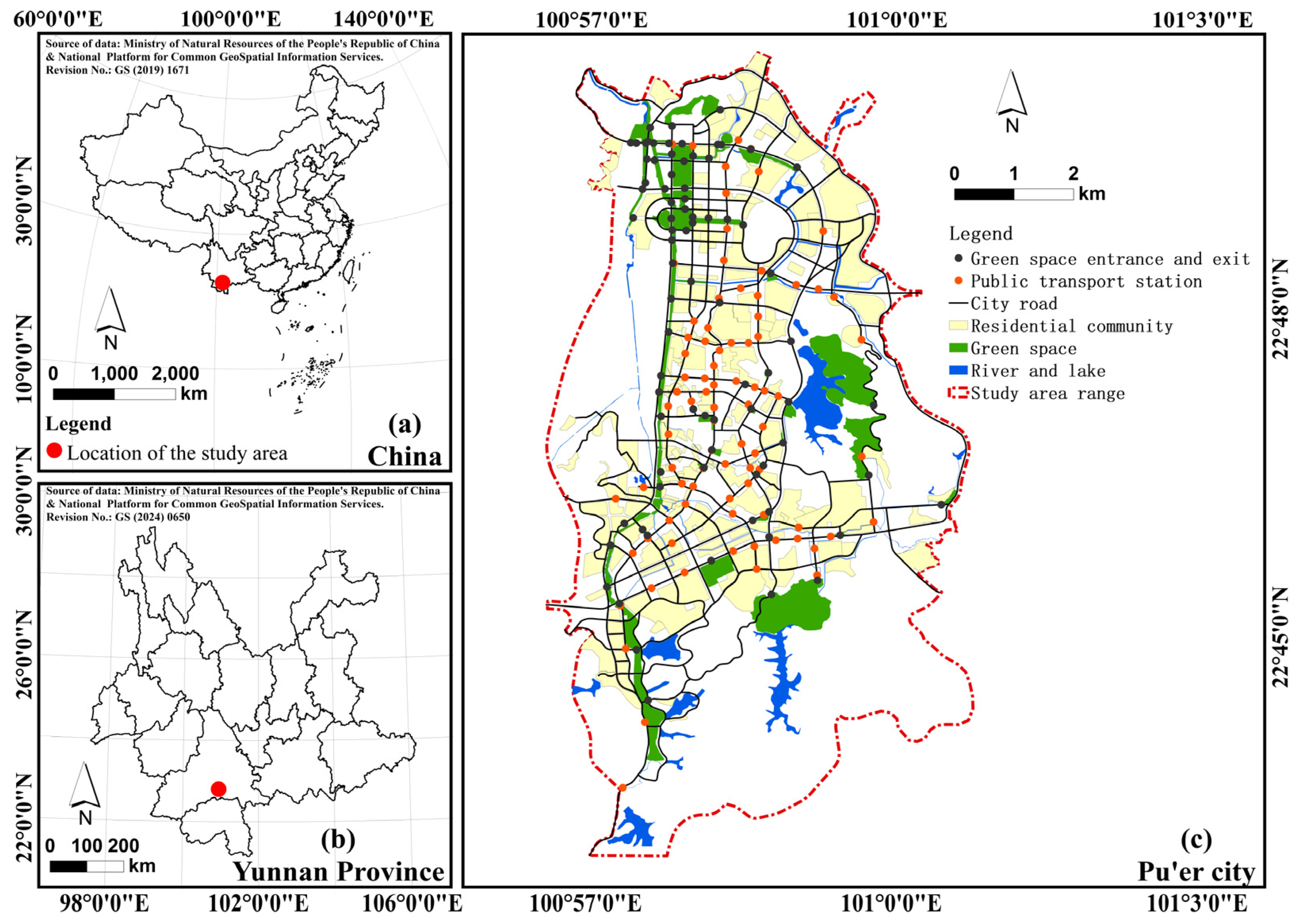

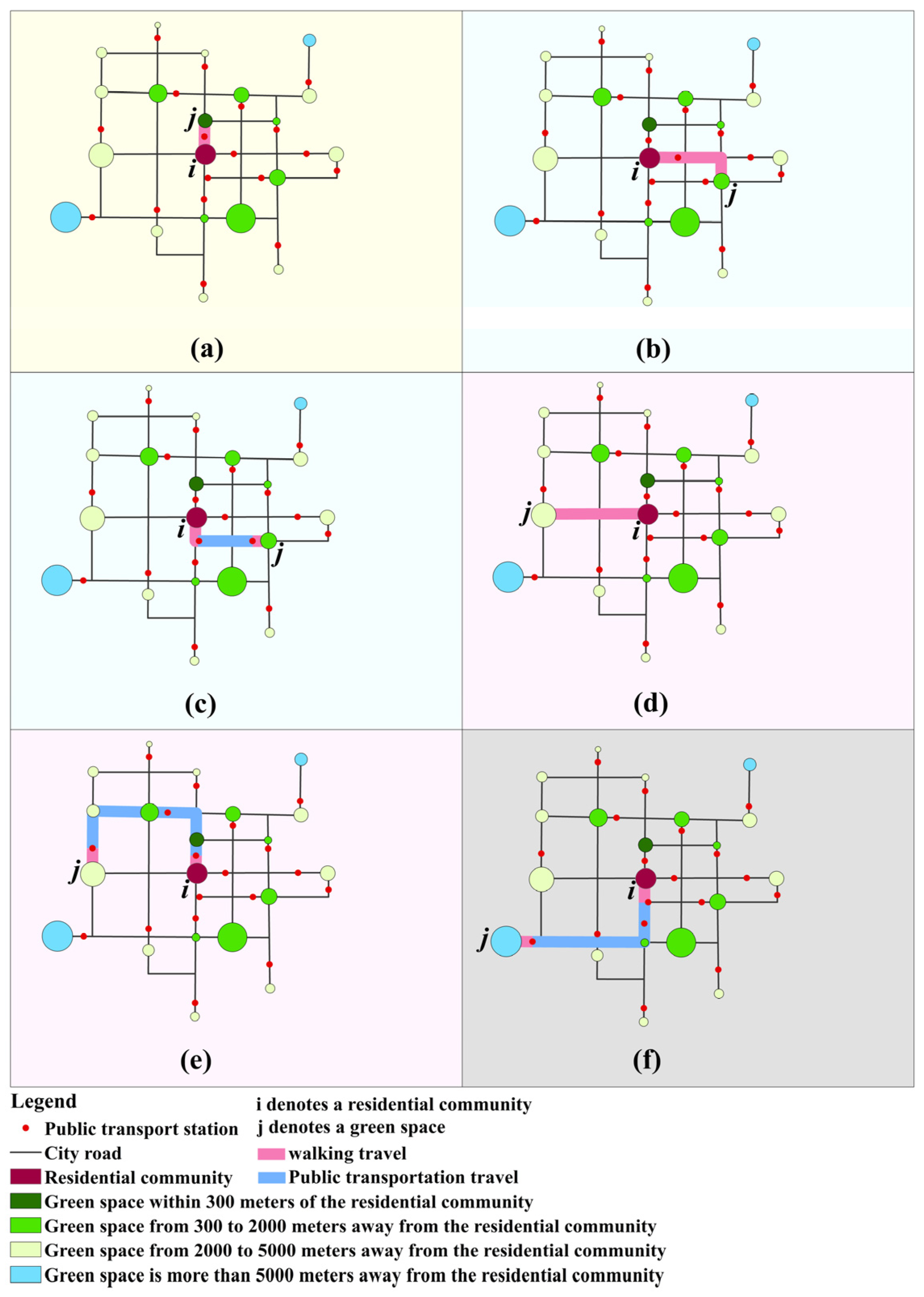
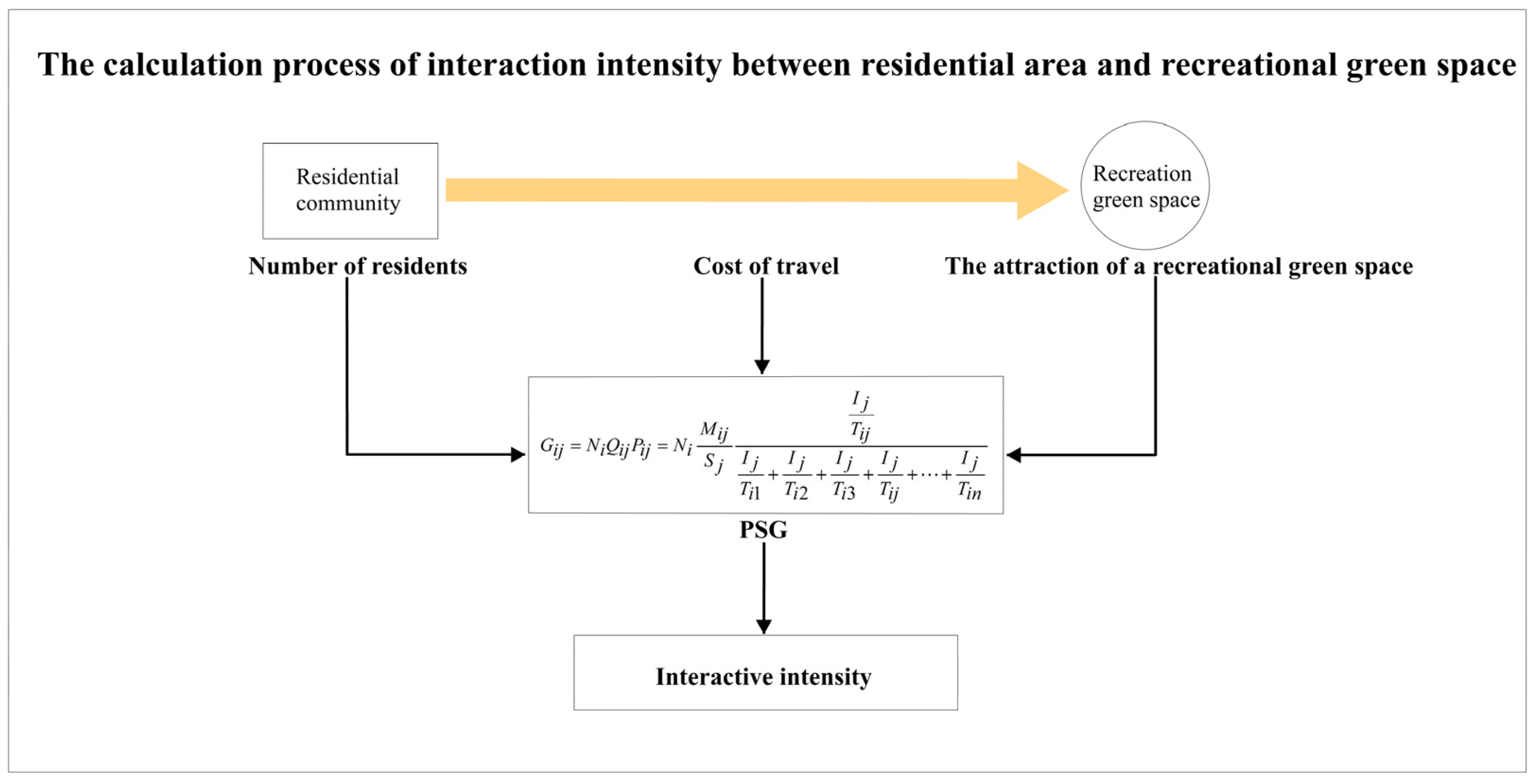

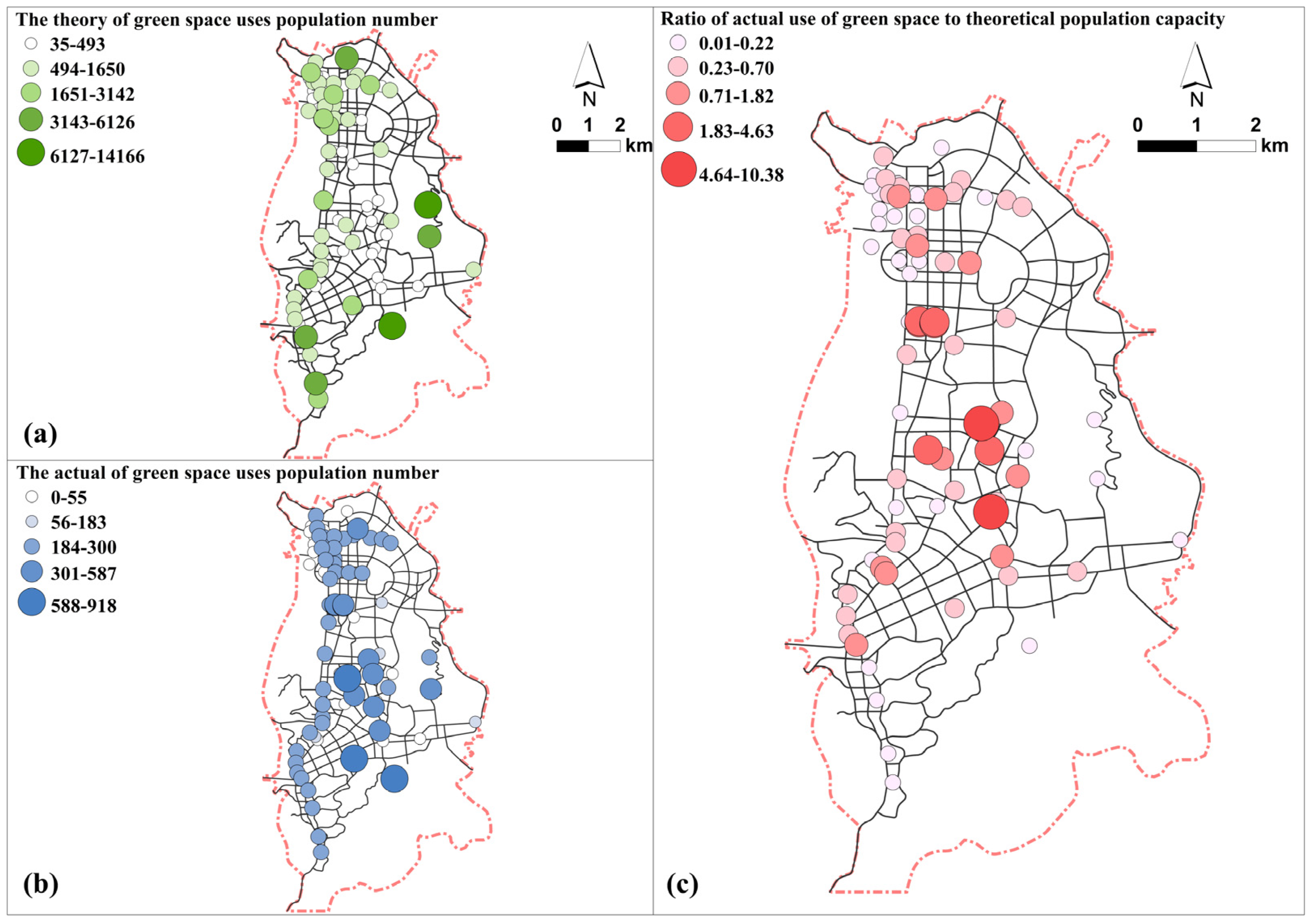
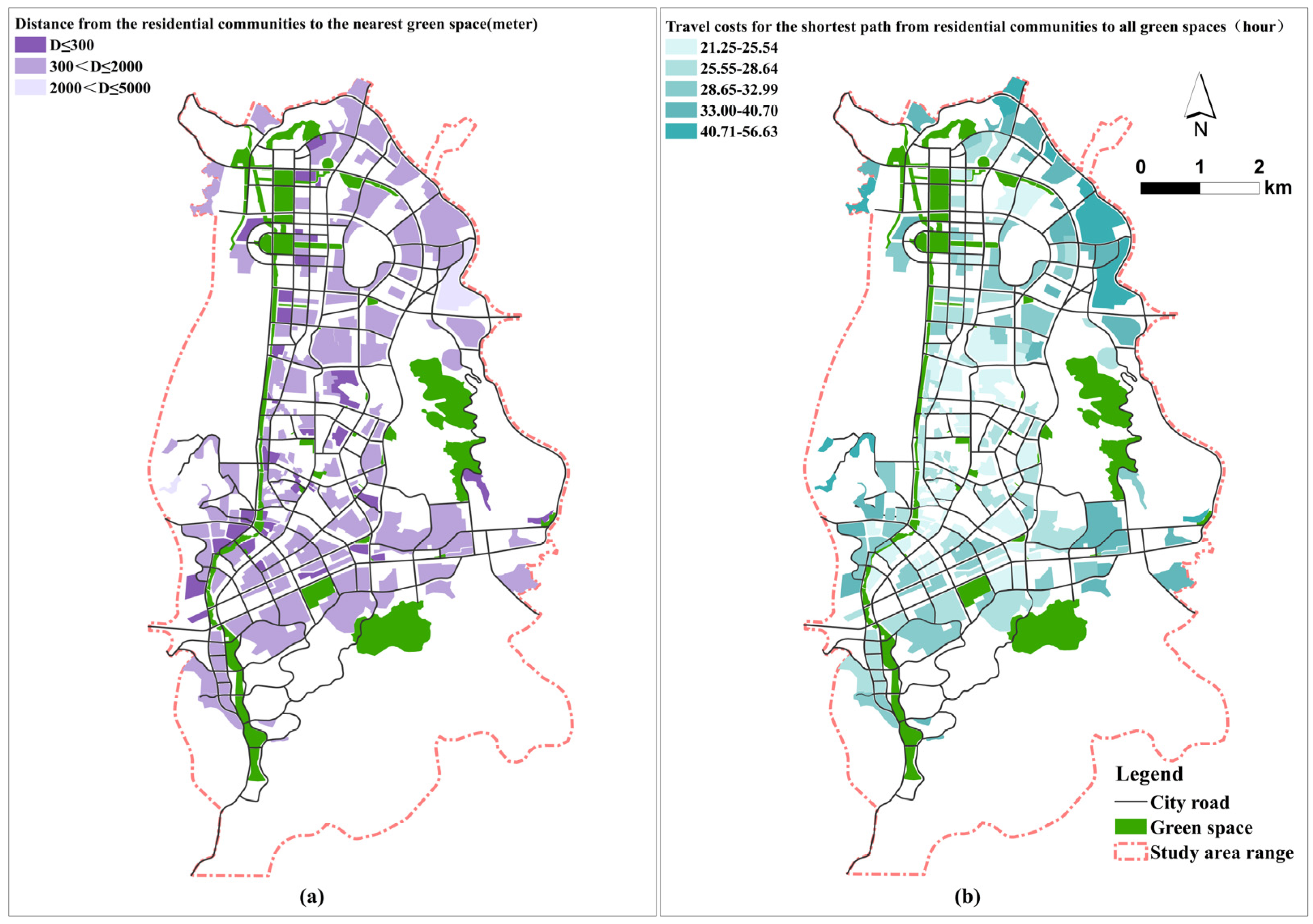
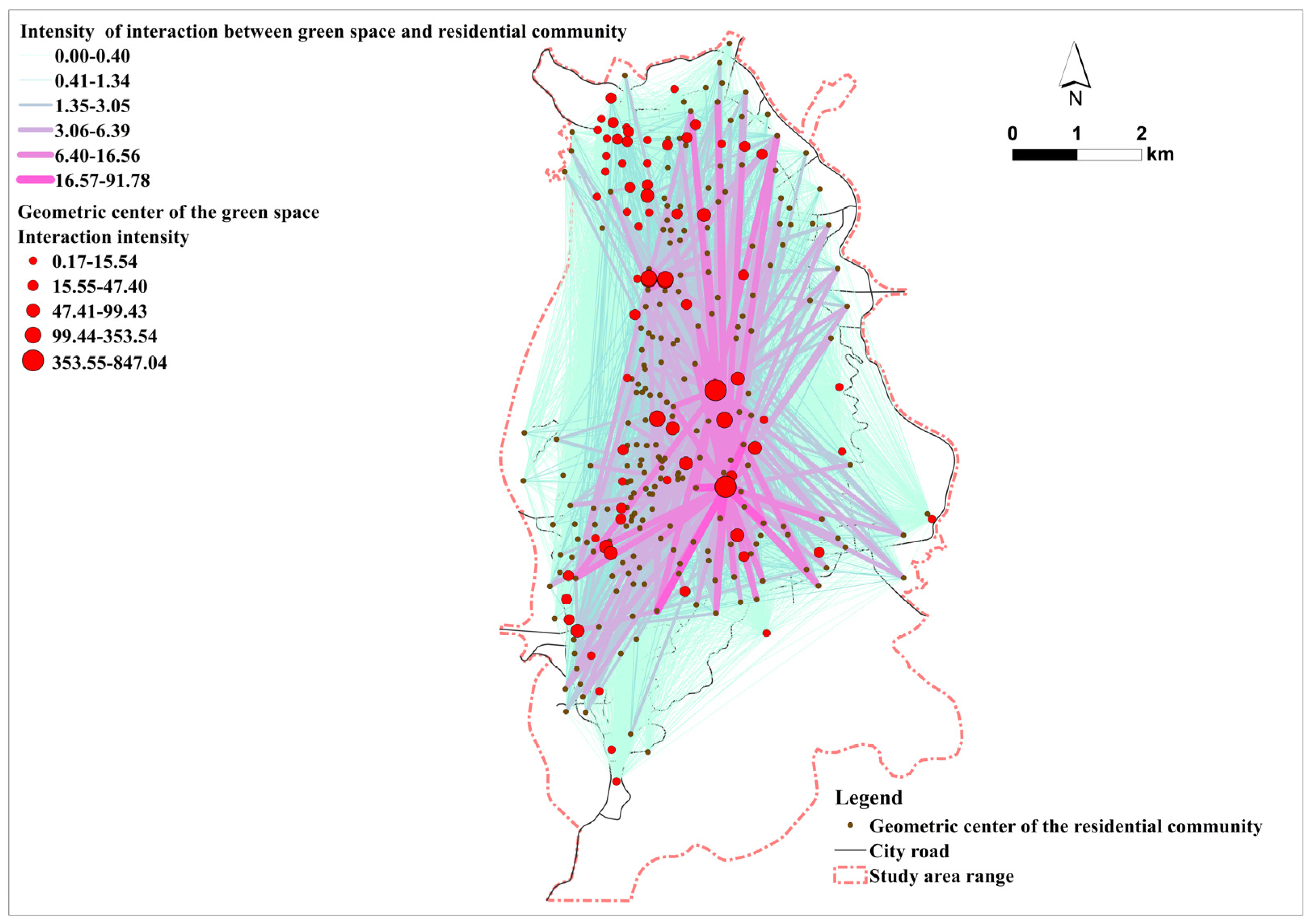
| Shortest Path Distance (m) | D ≤ 300 | 300 < D ≤ 2000 | 2000 < D ≤ 5000 | 5000 < D |
|---|---|---|---|---|
| number of residential areas that can be reached (s) | 44 | 175 | 2 | 0 |
| proportion of the total number of residential areas (%) | 19.91 | 79.19 | 0.90 | 0.00 |
| number of reachable population (people) | 43446 | 243720 | 2496 | 0 |
| proportion of total population (%) | 15.00 | 84.14 | 0.86 | 0 |
| Travel Cost (hours) | 21.25–28.33 | 28.34–35.40 | 35.41–42.48 | 42.49–49.55 | 49.56–56.63 |
|---|---|---|---|---|---|
| number of residential areas (s) | 130 | 63 | 17 | 8 | 3 |
| proportion of total residential area (%) | 58.82 | 28.51 | 7.69 | 3.62 | 1.36 |
| number of residents (person) | 174275 | 79832 | 28276 | 4314 | 2965 |
| proportion of total population (%) | 60.17 | 27.56 | 9.76 | 1.49 | 1.02 |
Disclaimer/Publisher’s Note: The statements, opinions and data contained in all publications are solely those of the individual author(s) and contributor(s) and not of MDPI and/or the editor(s). MDPI and/or the editor(s) disclaim responsibility for any injury to people or property resulting from any ideas, methods, instructions or products referred to in the content. |
© 2024 by the authors. Licensee MDPI, Basel, Switzerland. This article is an open access article distributed under the terms and conditions of the Creative Commons Attribution (CC BY) license (https://creativecommons.org/licenses/by/4.0/).
Share and Cite
Xu, C.; Zhang, J.; Xu, Y.; Wang, Z. Developing a Model to Study Walking and Public Transport to Attractive Green Spaces for Equitable Access to Health and Socializing Opportunities as a Response to Climate Change: Testing the Model in Pu’er City, China. Forests 2024, 15, 1944. https://doi.org/10.3390/f15111944
Xu C, Zhang J, Xu Y, Wang Z. Developing a Model to Study Walking and Public Transport to Attractive Green Spaces for Equitable Access to Health and Socializing Opportunities as a Response to Climate Change: Testing the Model in Pu’er City, China. Forests. 2024; 15(11):1944. https://doi.org/10.3390/f15111944
Chicago/Turabian StyleXu, Chengdong, Jianpeng Zhang, Yi Xu, and Zhenji Wang. 2024. "Developing a Model to Study Walking and Public Transport to Attractive Green Spaces for Equitable Access to Health and Socializing Opportunities as a Response to Climate Change: Testing the Model in Pu’er City, China" Forests 15, no. 11: 1944. https://doi.org/10.3390/f15111944
APA StyleXu, C., Zhang, J., Xu, Y., & Wang, Z. (2024). Developing a Model to Study Walking and Public Transport to Attractive Green Spaces for Equitable Access to Health and Socializing Opportunities as a Response to Climate Change: Testing the Model in Pu’er City, China. Forests, 15(11), 1944. https://doi.org/10.3390/f15111944





